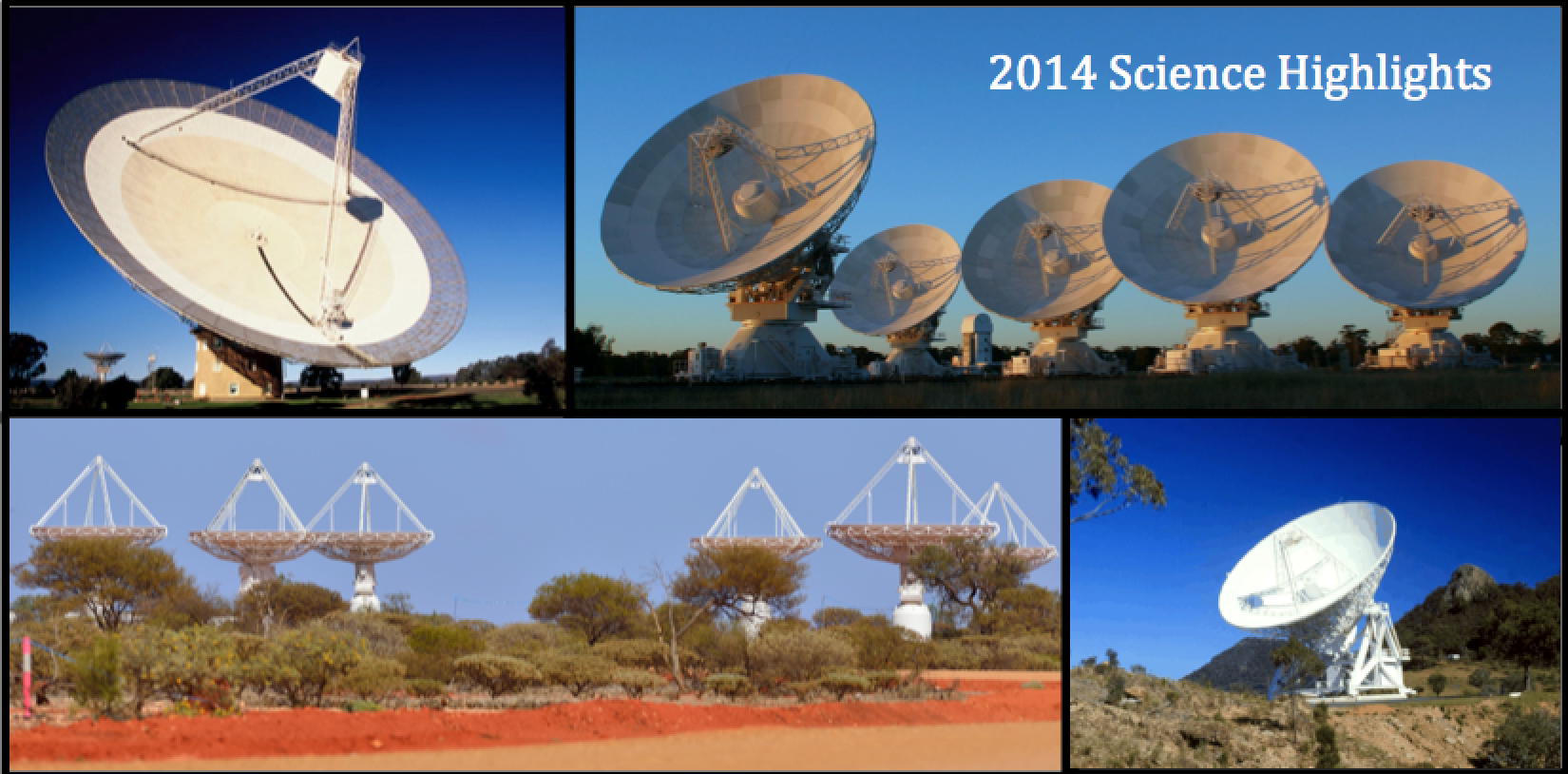ATNF Science Highlights 2014
|
Calabretta, Staveley-Smith & Barnes (2014, PASA
31, 7) carefully reprocessed archival data from the HI Parkes All-Sky
Survey (HIPASS) and the HI Zone of Avoidance (HIZOA) survey into a new
1.4 GHz continuum map of the sky. The wide sky coverage (Dec < +25 degr),
high sensitivity of 40 mK (limited by confusion), resolution of 14.4
arcmin and low level of artefacts make this map ideal for numerous
studies, including: merging into interferometer maps to complete
large-scale structures; decomposition of thermal and non-thermal
emission components from Galactic and extragalactic sources; and
comparison of emission regions with other frequencies. The new map
is available for download.
| 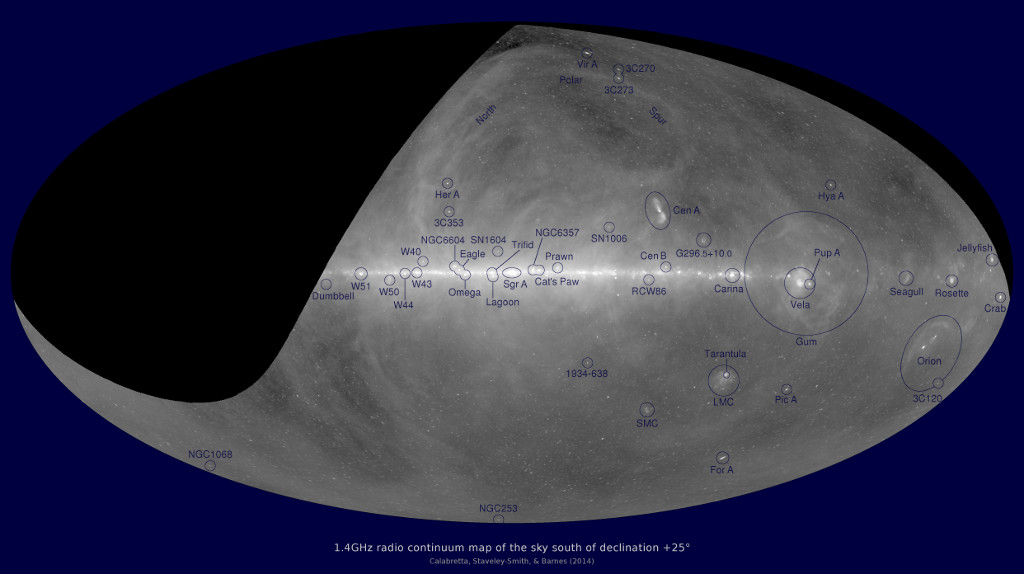
| |
Brook et al. (2014, ApJ 780, L31) present
the results of long-term monitoring of PSR J0738-4042 with the Parkes
telescope. They found that its pulse shape changed multiple times
between 1988 and 2012. The torque, inferred via the derivative of the
rotational period, changes abruptly from 2005 September. This change
is accompanied by an emergent radio component that drifts with respect
to the rest of the pulse. No known intrinsic pulsar processes can
explain these timing and radio emission signatures. The data lead them
to postulate that we are witnessing an asteroid falling into the
magnetosphere of the pulsar. - Paul Brook is a student at Oxford
University in the UK and a co-supervised student at CSIRO Astronomy
and Space Science (CASS).
| 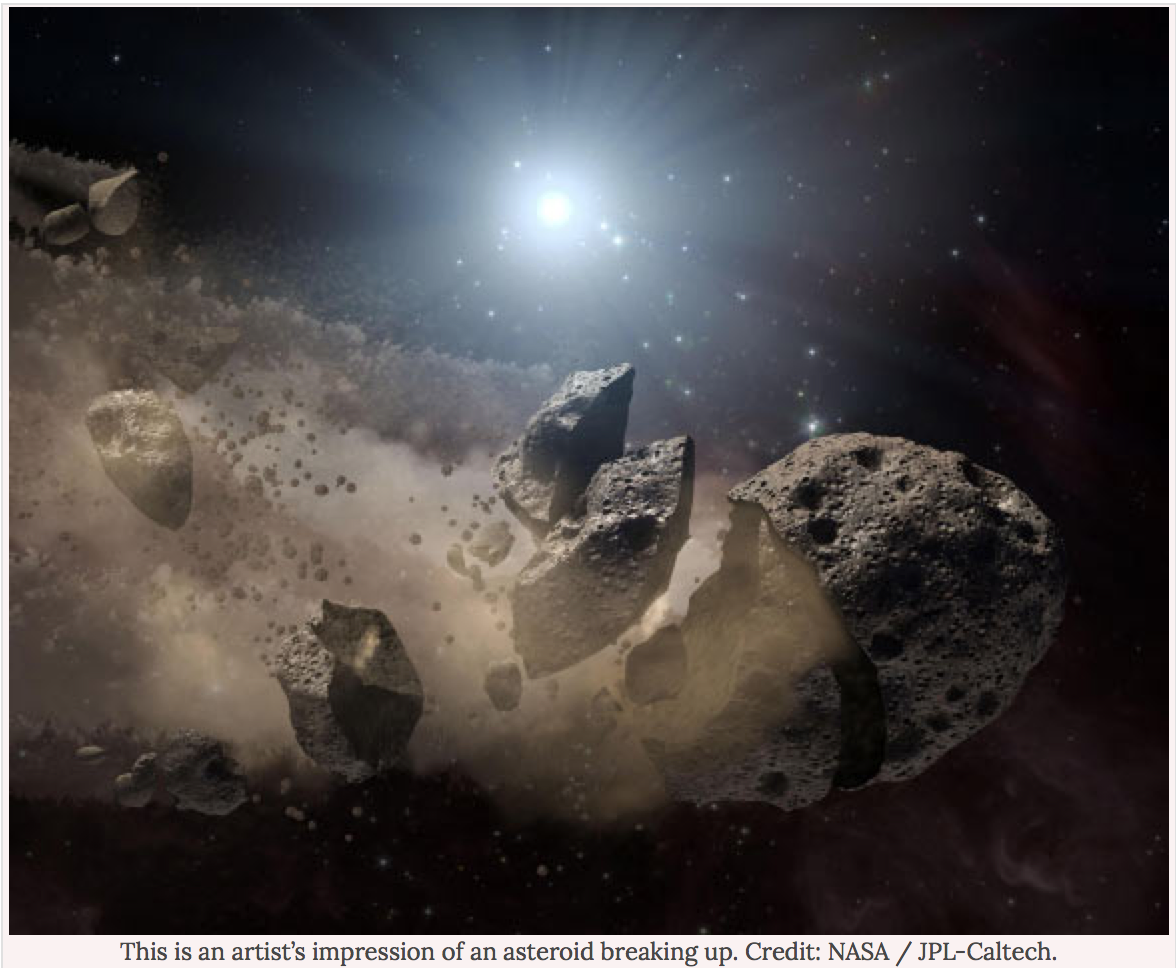
| |
Shannon, Johnston & Manchester (2014, MNRAS
437, 3255) present an analysis of 23 yr of pulse arrival times for
PSR B1259-63. The pulsar is in a binary orbit about its approximately
20 Msun companion LS 2883. Their best-fitting timing solution has none
of the pulse-number ambiguities that have plagued previous attempts to
model the binary orbit. By combining proper motion of the pulsar with
radial velocity measurements of the companion, they measure the 3D
velocity of the system, which is then used to constrain the masses of
the stars prior to the supernova explosion and the kick the pulsar
received at or immediately after the explosion.
| 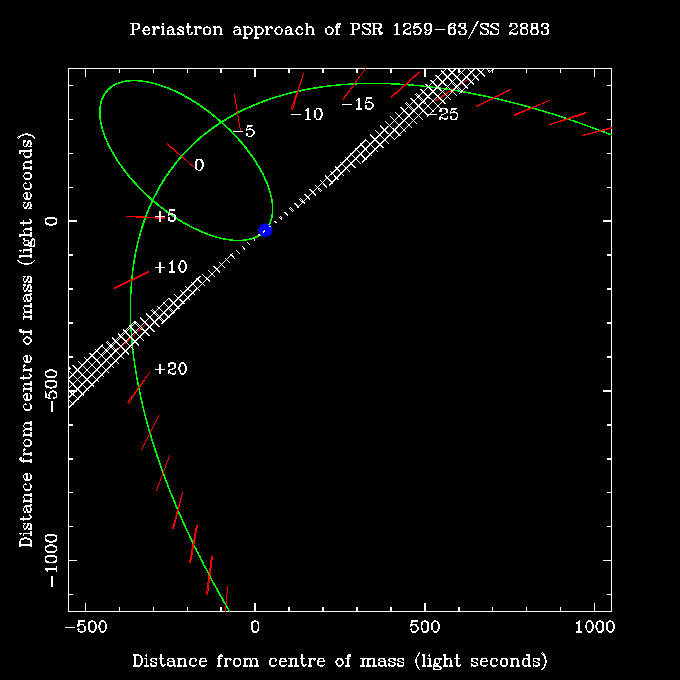
| |
Michalowski et al. (2014, A&A 562, 70) present
spatially resolved maps of dust emission of the host galaxy of the
closest known GRB 980425 at z = 0.0085 using our new high-resolution
observations from Herschel, Atacama Pathfinder Experiment (APEX),
Atacama Large Millimeter Array (ALMA) and Australia Telescope Compact
Array (ATCA). Gamma-ray bursts (GRBs) have been proposed as a tool for
studying star formation in the Universe, so it is crucial to investigate
whether their host galaxies and immediate environments are in any way
special compared with other star-forming galaxies. - The R-band image
to the right is overlaid with radio continuum ATCA contours at 1.324
and 2.348 GHz; fits files provided on-line, with thanks to Michalowski
et al. (2014).
| 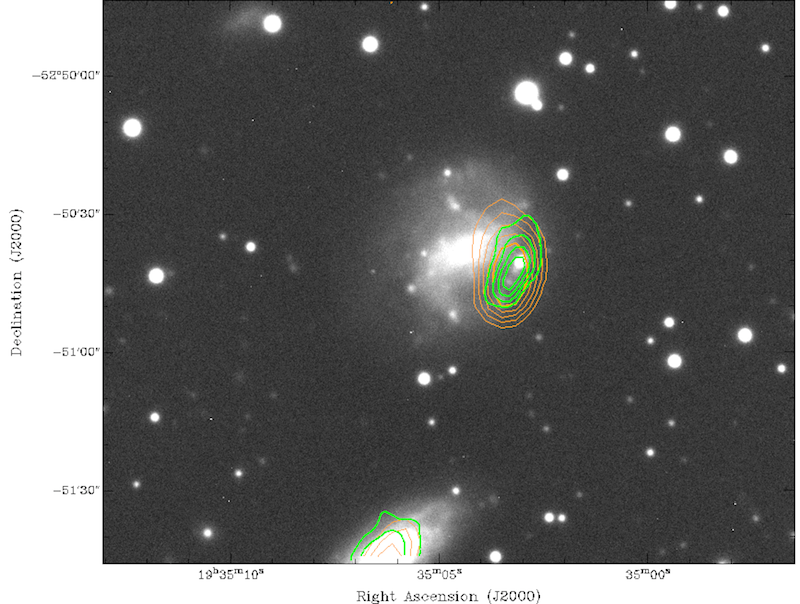
| |
Furukawa et al. (2014, ApJ 781, 70) present new
12CO and 13CO (J=2-1 and J=1-0) observations of two
molecular clouds made with NANTEN2 and the Mopra Telescope. The so-called
"jet" and "arc" clouds are loacted toward the stellar cluster Westerlund
2, RCW49, and the TeV gamma-ray source HESS J1023-575. Furukawa et al.
suggest that neither are physically linked with Westerlund 2 but are
located at a greater distance around 7.5 kpc.
| 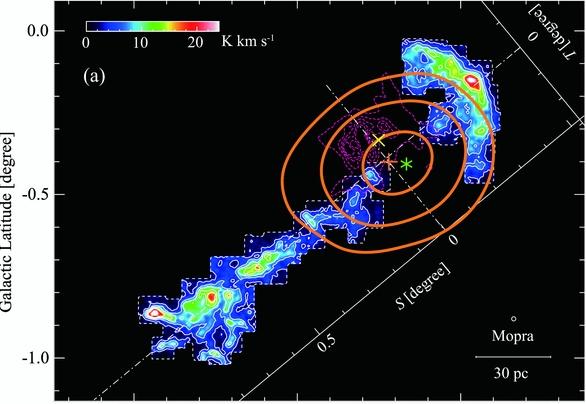
| |
Emonts et al. (2014, MNRAS 438, 2898) present
a CO(1-0) survey for cold molecular gas in a representative sample of
13 high-z radio galaxies (HzRGs) at 1.4 < z < 2.8, using the Australia
Telescope Compact Array (ATCA). They detect CO(1-0) emission associated
with five sources: MRC 0114-211, MRC 0152-209, MRC 0156-252,
MRC 1138-262 (Spiderweb Galaxy) and MRC 2048-272. Intriguingly, in all
five sources the CO(1-0) emission is found up to tens of kpc from the
host galaxy. In several cases the CO(1-0) traces a large reservoir of
cold gas at the tip of the radio source, which suggests that jet-induced
feedback can trigger the formation of cold molecular gas in the halo
environment of high-z radio galaxies. These results show that the
compact hybrid array configurations of the ATCA are sensitive to
tracing the most widespread and possibly diffuse molecular gas in the
Early Universe, something that cannot be efficiently done by any other
radio telescope. - The image shows CO(1-0) emission (in blue) spread
across the inter-galactic medium of the massive Spiderweb Galaxy at
z=2.16 (high-resolution follow-up, as shown by the line-profile on
the top-right, is in progress).
| 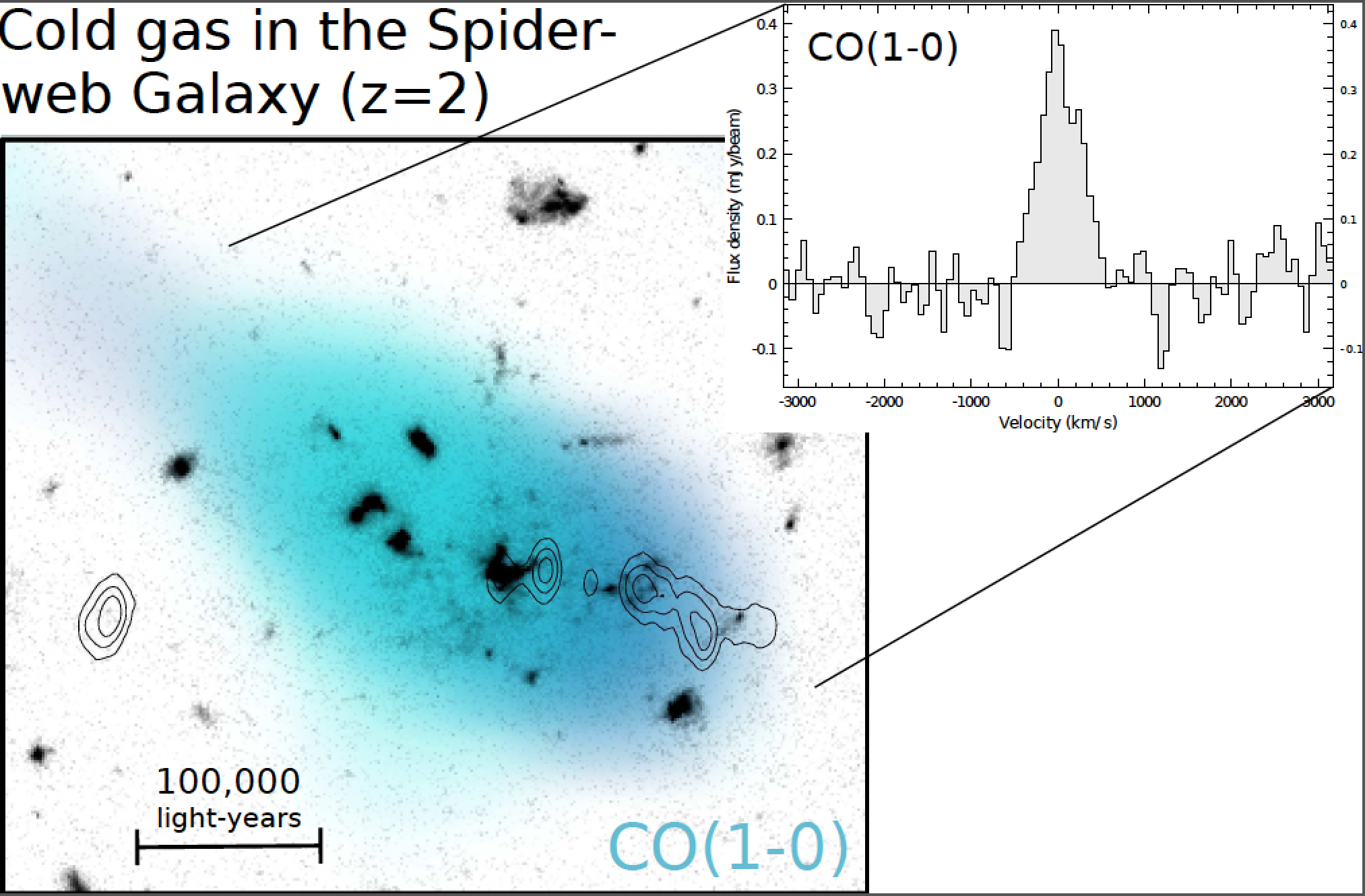
| |
Ott et al. (2014, ApJ 785, 55) present a
large-scale, interferometric survey of ammonia toward the Galactic center
observed with the Australia Telescope Compact Array (ATCA). The survey
covers the region between the supermassive black hole Sgr A* and the
massive star forming region Sgr B2 with a resolution of about 20 arcsec
(0.8 pc). Emission at scales larger than 2 arcmin (3.2 pc) is filtered
out due to missing short spacings. Consequently, the data represent the
denser, compact clouds and disregard the large-scale, diffuse gas. -
The RGB image shows the temperature map of the Galactic center:
Tkin ~ 30 K (blue), Tkin ~ 50 K (green), lower
limit of 80 K (red). Radio continuum emission at 22 GHz (1 cm; white
contours) is overlaid in the bottom panel.
| 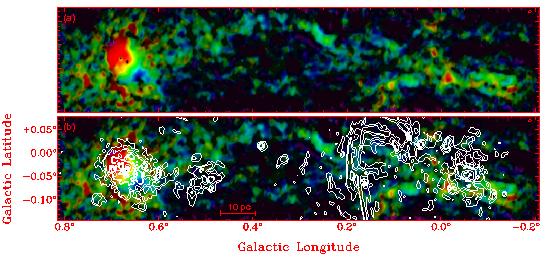
| |
Voronkov et al. (2014, MNRAS 439, 2584) used
the Australia Telescope Compact Array (ATCA) for high angular resolution
imaging of 71 southern class I methanol maser sources quasi-simultaneously
at 36 and 44 GHz. This is the largest interferometric survey of common
class I methanol masers available to date, and the first of this kind in
the southern hemisphere. In addition, this is the first high angular
resolution study of a large number of 36 GHz masers. The data reveal a
high level of morphological and kinematical complexity, and allow them
to demonstrate associations, at arcsecond precision, of the class I maser
emission with outflows, expanding HII regions, dark clouds, shocks
traced by the 4.5 micron emission and 8.0 micron filaments. More than
700 maser component features were found at each of the two methanol
transitions.
| 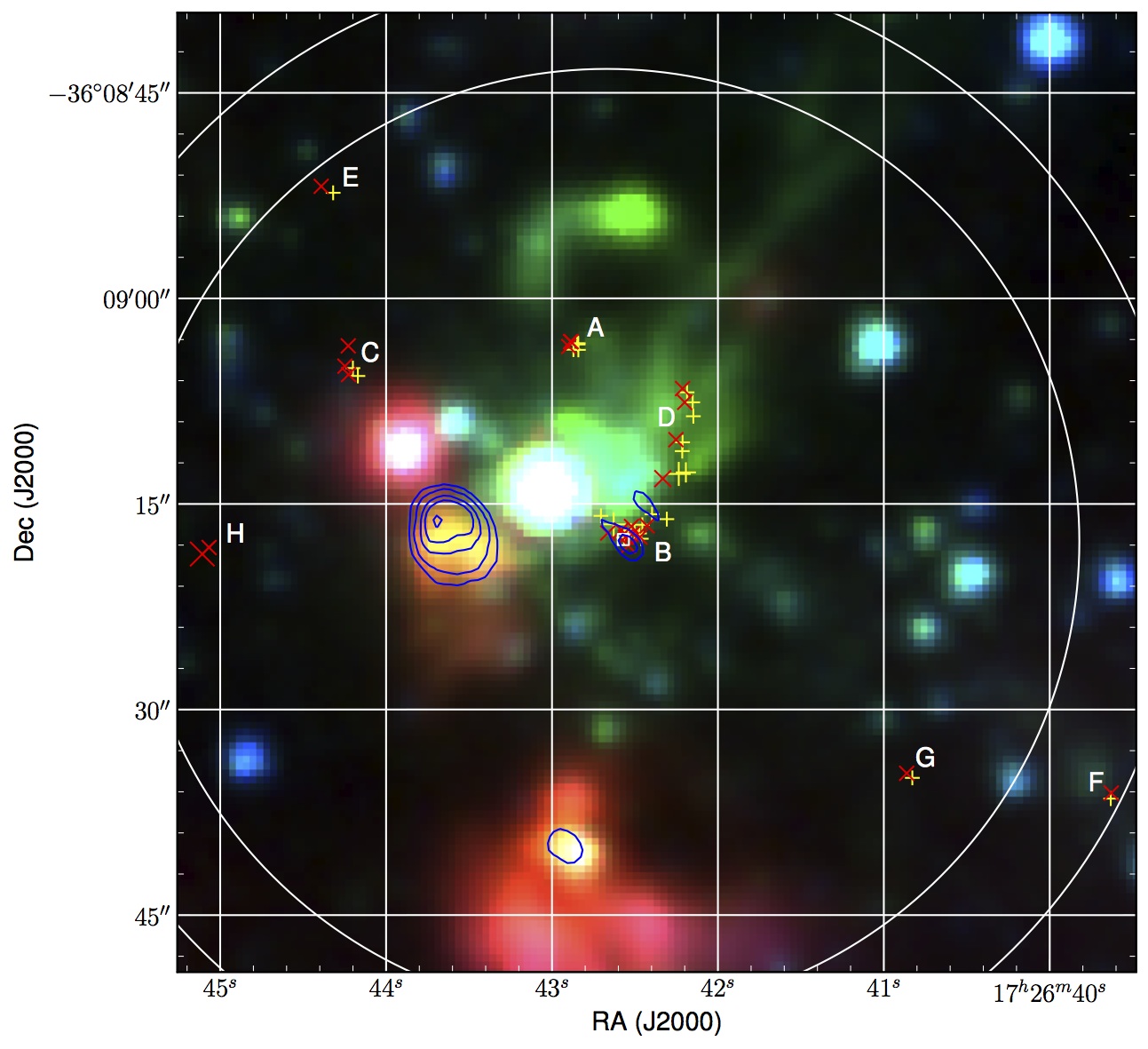
| |
Cormier et al. (2014, A&A 564, 121) present
CO observations obtained at the ATNF Mopra 22-m, APEX, and IRAM 30-m
telescopes in 6 nearby low-metallicity galaxies. For the first time,
they detect CO(1-0) in NGC625 and get strong limits for Haro11 and
UM311 thanks to Mopra. While those galaxies are forming stars, CO is
faint. The molecular gas masses derived from CO and dust methods are
quite discrepant and stress the large uncertainties on the true
molecular mass present in these compact galaxies which may harbor a
significant reservoir of ``CO-dark'' molecular gas.
| 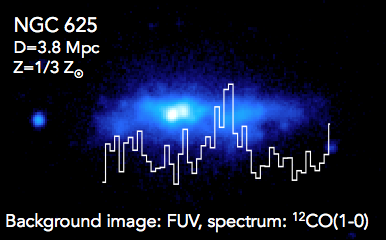
| |
Lindner et al. (2014, ApJ 789, 49) present
610 MHz and 2.1 GHz imaging of the massive Sunyaev-Zel'dovich Effect
selected z = 0.870 cluster merger ACT-CL J0102-4915 ("El Gordo"),
obtained with the Giant Metrewave Radio Telescope and the Australia
Telescope Compact Array (ATCA), respectively. They detect two complexes
of radio relics separated by 3.4 arcmin (1.6 Mpc) along the system's
northwest-to-southeast collision axis that have high integrated
polarization fractions (33%) and steep spectral indices, consistent
with creation via Fermi acceleration by shocks in the intracluster
medium triggered by the cluster collision.
| 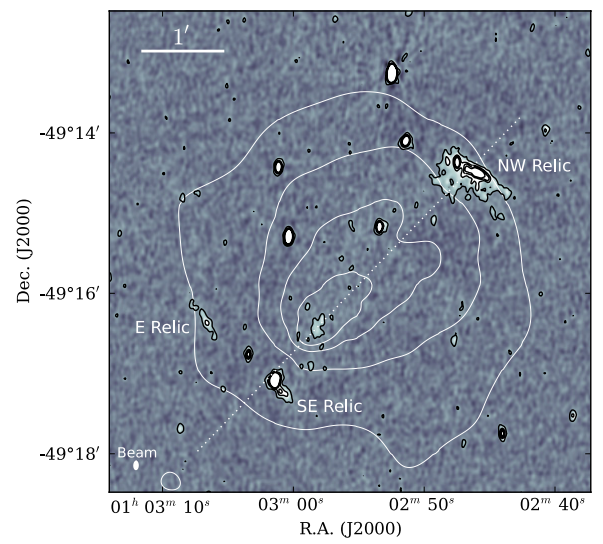
| |
Shimwell et al. (2014, MNRAS 440, 2901) present
deep 1.1-3.1 GHz Australia Telescope Compact Array (ATCA) observations
of the radio halo of the bullet cluster, 1E 0657-55.8. In comparison to
existing images of this radio halo, the detection in their images is at
higher significance. The radio halo is as extended as the X-ray emission
in the direction of cluster merger but is significantly less extended
than the X-ray emission in the perpendicular direction. These
observations support the theory that shocks and turbulence influence
the formation and evolution of radio halo synchrotron emission.
| 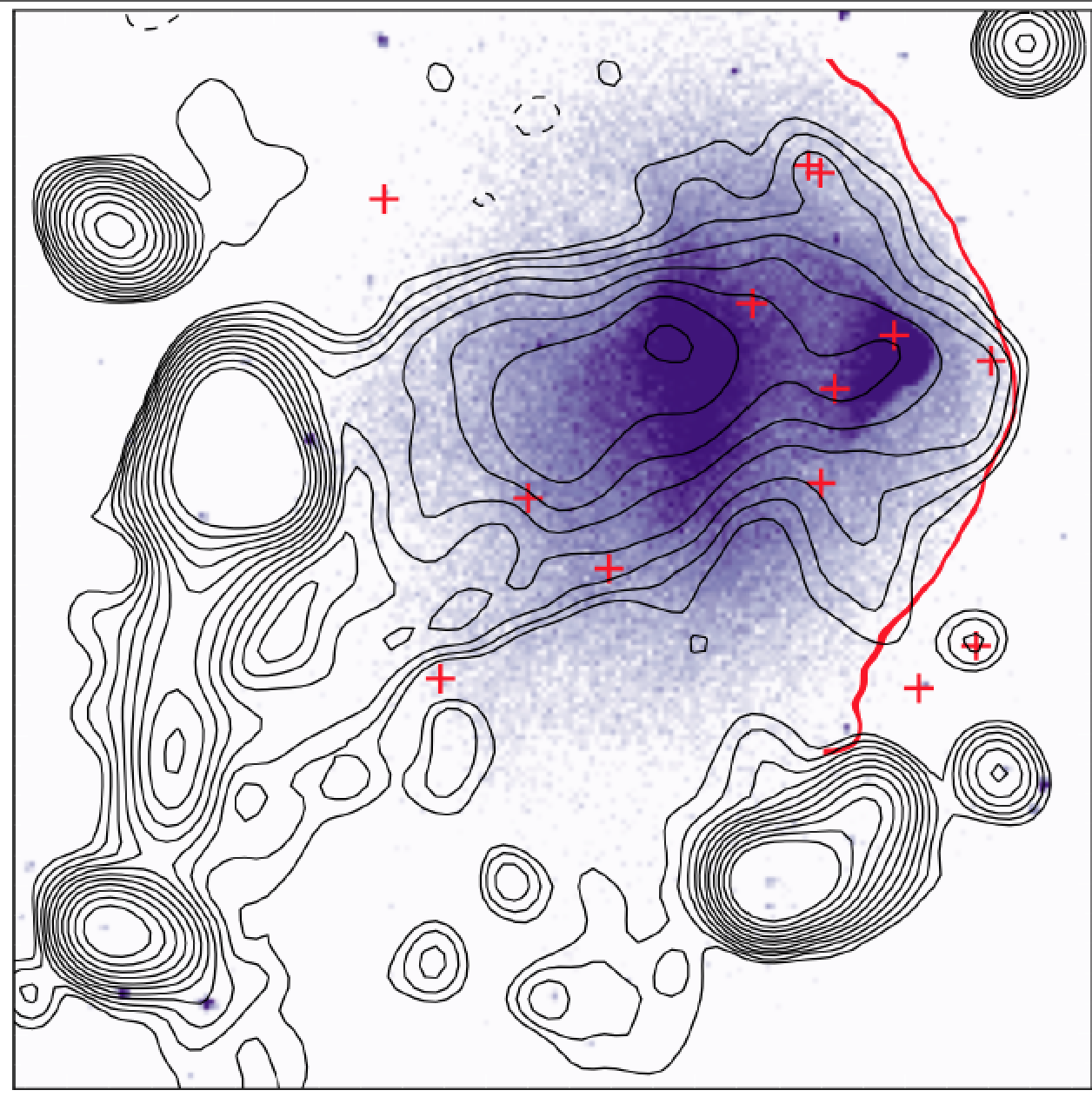
| |
Ellingsen et al. (2014, ApJ 790, L28) have
used the Australia Telescope Compact Array (ATCA) to search for emission
from the 36.2 GHz transition of methanol toward the center of the nearby
starburst galaxy NGC 253. Two regions of emission were detected, offset
from the nucleus along the same position angle as the inner spiral arms.
The 36.2 GHz methanol emission in NGC 253 has more than an order of
magnitude higher isotropic luminosity than the widespread emission
recently detected toward the center of the Milky Way. If emission from
this transition scales with the nuclear star formation rate, then it
may be detectable in the central regions of many starburst galaxies.
| 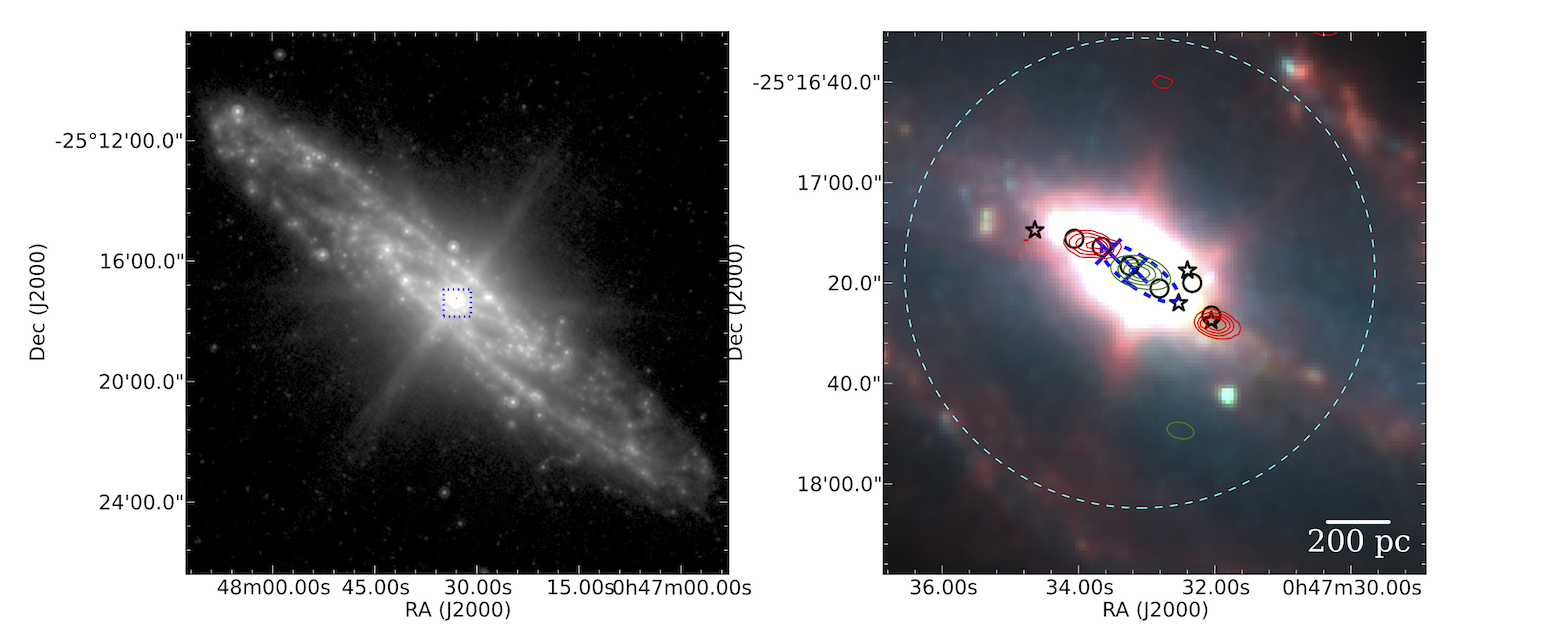
| |
Anderson et al. (2014, ApJ 793, 37) present
parsec-scale interferometric maps of HCN(1-0) and HCO+(1-0) emission
from dense gas in the star-forming region 30 Doradus, obtained using
the Australia Telescope Compact Array (ATCA). This extreme star-forming
region, located in the Large Magellanic Cloud (LMC), is characterized
by a very intense ultraviolet ionizing radiation field and sub-solar
metallicity, both of which are expected to impact molecular cloud
structure. They detect 13 bright, dense clumps within the 30 Doradus-10
giant molecular cloud.
| 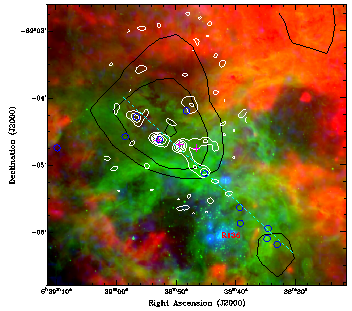
| |
Burke-Spolaor & Bannister (2014, ApJ 792, 19)
report the detection of a dispersed fast radio burst (FRB) in archival
intermediate-latitude Parkes Radio Telescope data. The burst appears
to be of the same physical origin as the four purported extragalactic
FRBs reported by Thornton et al. They consider that this survey, and
many other archival low-latitude pulsar surveys, have been searched
for FRBs but produced fewer detections than the comparatively brief
Thornton etal. search. Such a rate dependence on Galactic position
could provide critical supporting evidence for an extragalactic origin
for FRBs.
| 
| |
Mueller et al. (2014, A&A 569, 115) observed
the active galactic nucleus of Centaurus A (CenA) approximately every
six months at 8.4 GHz with the Australian Long Baseline Array (LBA) and
associated telescopes in Antarctica, Chile, New Zealand, and
South Africa, complemented by quasi-simultaneous 22.3 GHz observations.
The first seven epochs of high-resolution TANAMI VLBI observations are
presented, resolving the jet on (sub-)milliarcsecond scales.
| 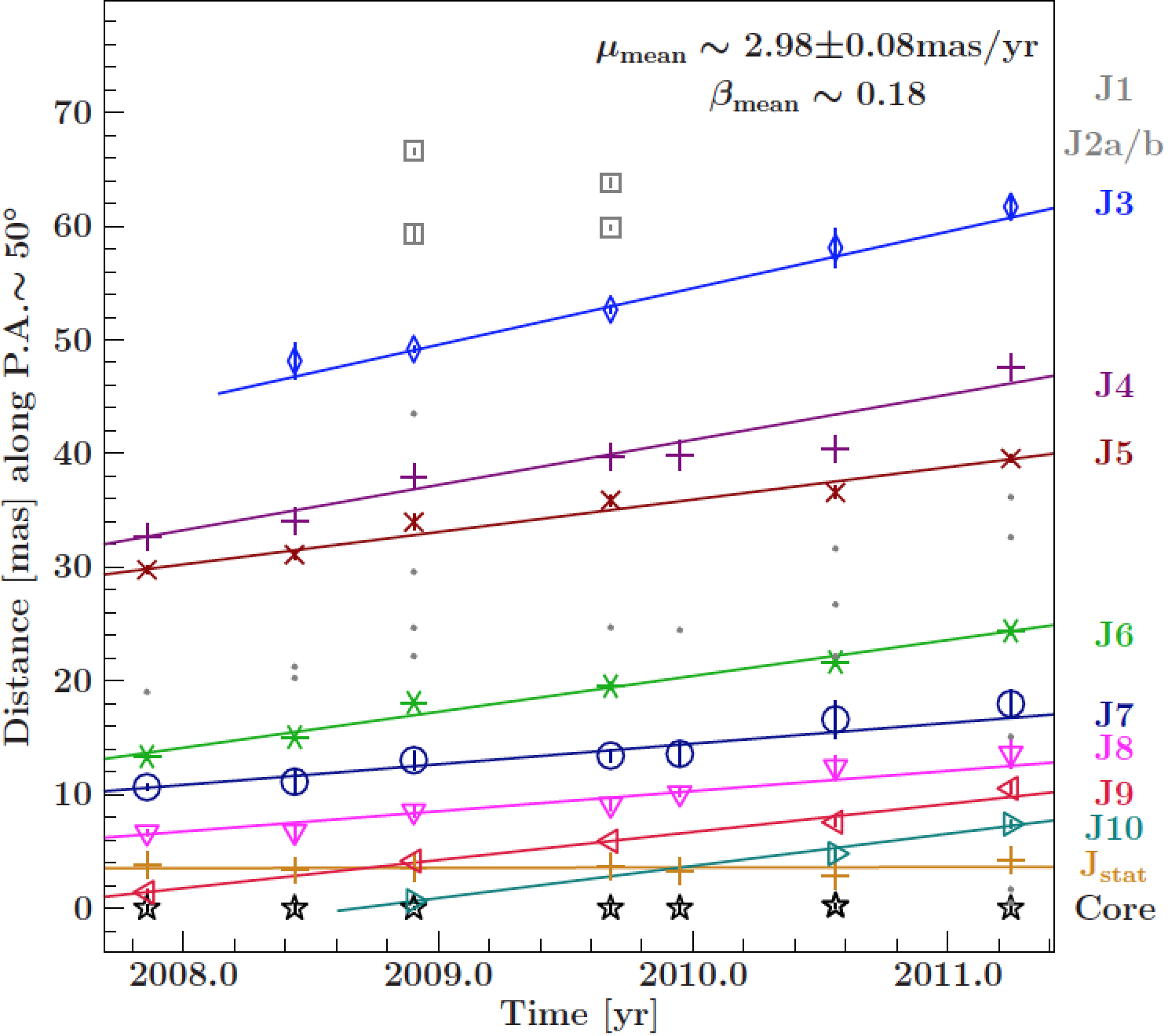
| |
Hong et al. (2014, MNRAS 445, 402) use 2MASS
near-infrared photometry and high signal-to-noise HI 21-cm data from the
Arecibo, Green Bank, Nancay, and Parkes telescopes to calculate the
redshift-independent distances and peculiar velocities of 2018 bright
inclined spiral galaxies over the whole sky. This project is part of
the 2MASS Tully-Fisher survey (2MTF), aiming to map the galaxy peculiar
velocity field within 100 Mpc.
| 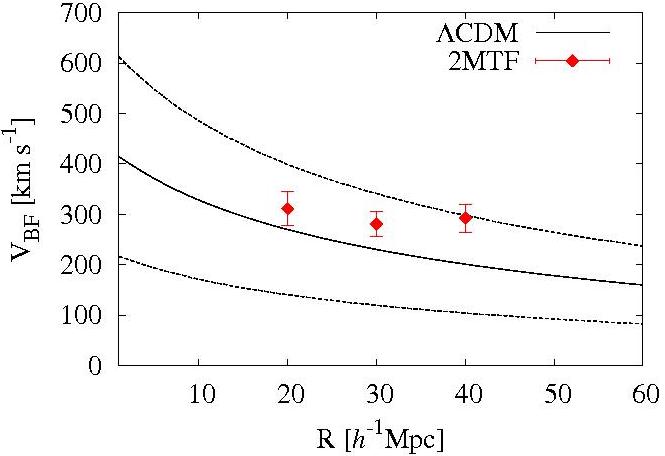
| |
Kerr et al. (2014, MNRAS 445, 320) studied the
emission from PSR J1717-4054 over intervals from single pulses to years
using the Parkes radio telescope and the Australia Telescope Compact
Array (ATCA). They identified and characterized nulling at three discrete
time-scales: the pulsar emits during `active states' separated by nulls
lasting many thousands of rotations, while active states themselves are
interrupted by nulls with a bimodal distribution of durations - one to
two rotations, or tens of rotations.
| 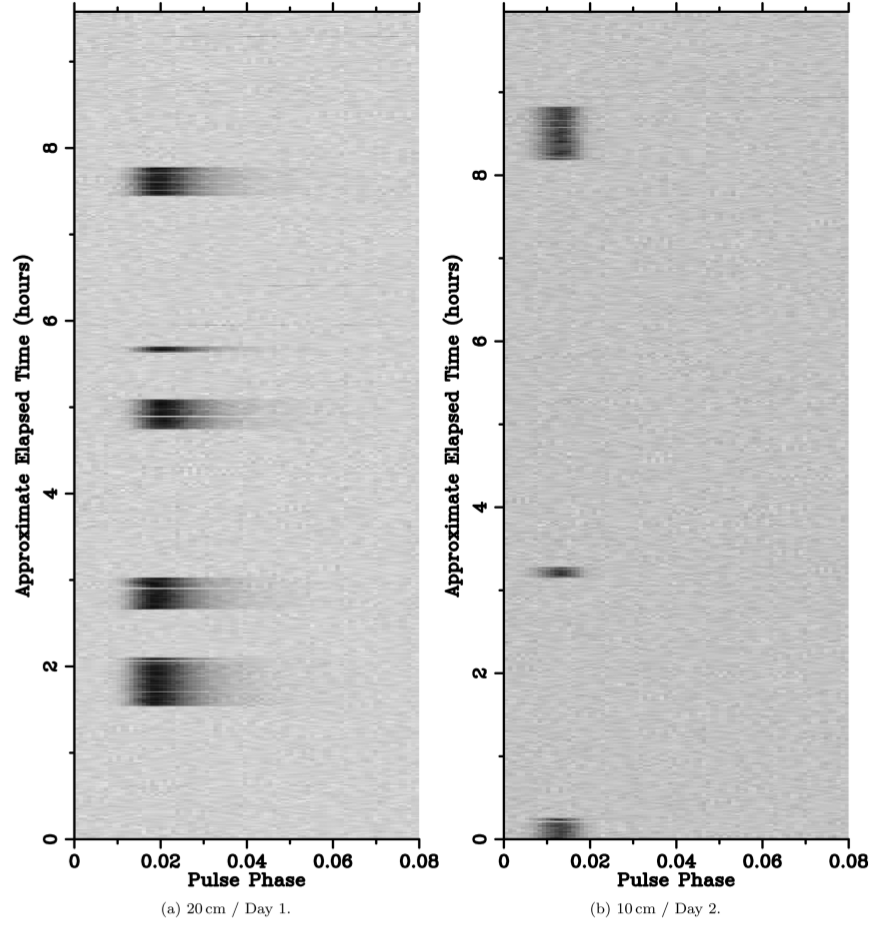
| |
Maccagni et al. (2014, A&A 571, 67) present
new Australia Telescope Compact Array (ATCA) observations of the young
radio galaxy PKS B1718-649. They study the morphology and the kinematics
of the neutral hydrogen (HI) disk and focus on analyzing the cold gas
in relation to the triggering of the nuclear activity. The different
kinematical properties of two distinct HI absorption lines suggest that
PKS B1718-649 may belong to a family of young low-excitation radio AGN
where, rather than through a gas-rich merger, the active nuclei (AGN)
are triggered by local mechanisms such as accretion of small gas
clouds.
| 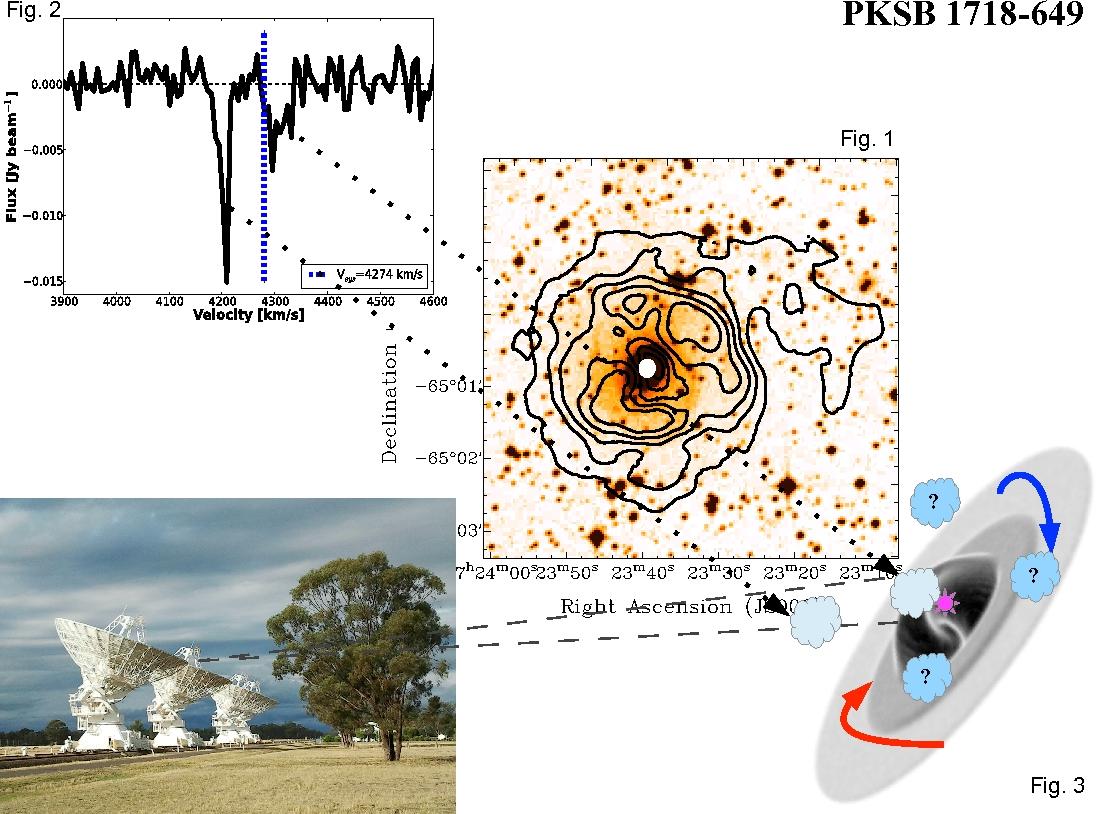
| |
Zanardo et al. (2014, ApJ 796, 82) present a
comprehensive spectral and morphological analysis of the remnant of
supernova (SN) 1987A with the Australia Telescope Compact Array (ATCA)
and the Atacama Large Millimeter/submillimeter Array (ALMA). The
non-thermal and thermal components of the emission from 94 to 672 GHz
are separated with the assistance of a synchrotron template from the
ATCA high-resolution observations at 44 GHz, and a dust template from
ALMA observations at 672 GHz. The synchrotron/dust-subtracted images
and the spectral energy distribution indicate additional emission
beside the main synchrotron component (alpha = -0.73) and the thermal
component originating from dust grains at T~22 K. Results from both
the morphological and spectral analysis suggest the presence of a
pulsar wind nebula in the remnant interior, powered by a pulsar likely
located at a westward offset from the SN position.
| 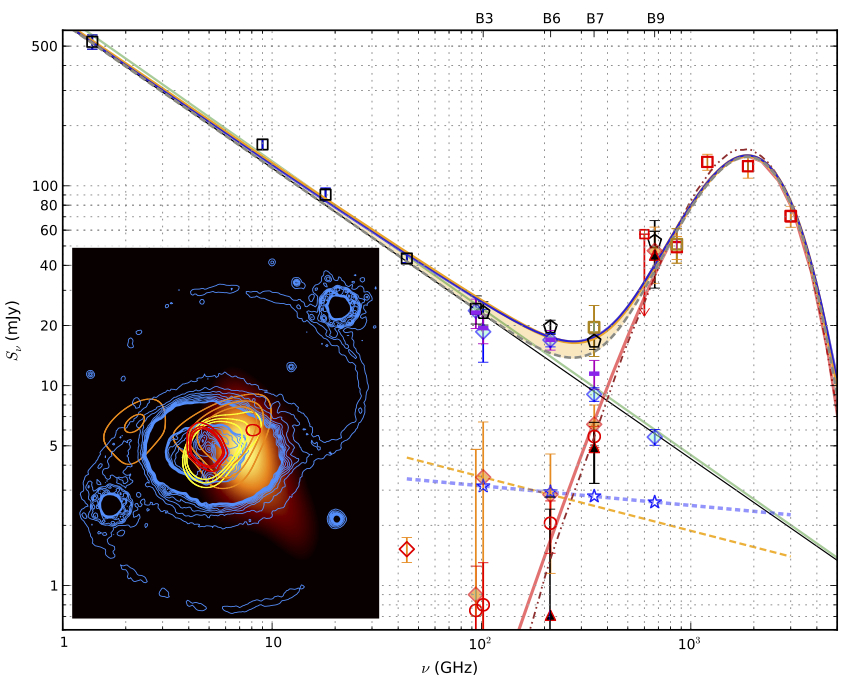
|
|

